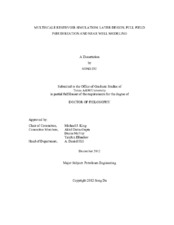| dc.description.abstract | In the past decades, considerable effort has been put into developing high resolution geological models for oil and gas reservoirs. Although the growth of computational power is rapid, the static model size still exceeds the model size for routine reservoir simulation. We develop and apply a variety of grid coarsening and refinement algorithms and single and multiphase upscaling approaches, applied to tight gas and conventional reservoir models.
The proposed research is organized into three areas. First the upgridding of detailed three dimensional geologic models is studied. We propose an improved layer design algorithm with considerations of accuracy and efficiency. This involves developing measures of reservoir heterogeneity and using these measures to design an optimal grouping of geologic model layers for flow simulation. The optimal design is shown to be a tradeoff between the desire to preserve the reservoir heterogeneity and a desire to minimize the simulation time. The statistical analysis is validated by comparison with flow simulation results.
Accurate upgridding/upscaling of single-phase parameters is necessary. However, it does not always satisfy the accuracy requirements, especially for the model which is aggressively coarsened. We introduce a pseudoization method with total mobility and effective fractional flow as the major targets. This pseudoization method helps to push upgridding/coarsening degree to the limit but still be able to reproduce the fine scale field performance. In practice, it is common to not use a different set of pseudos for every coarse cell; only a limited number of pseudo functions should be generated for different “rock types” or geological zones. For similar well patterns and well control conditions, applying pseudo is able to reproduce the fine scale performance for different simulation runs. This is the second proposed research area.
Finally, it is necessary to increase flow resolution for precise field history matching and forecasting. This has received increasing attention, especially when studying hydraulically fractured wells in unconventional reservoirs. We propose a multiscale reservoir simulation model combining local grid refinement (LGR) and pillar-based upscaling for tight gas reservoir performance prediction. Pillar-based coarsening away from the wells is designed for tight gas reservoirs. It compensates for the extra computational cost from LGR, which is used to represent hydraulic fractures. Overall reservoir performances, including the accuracy and efficiency, are evaluated. | en |


